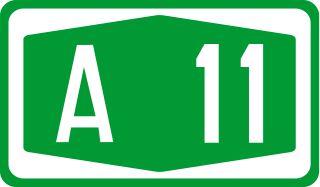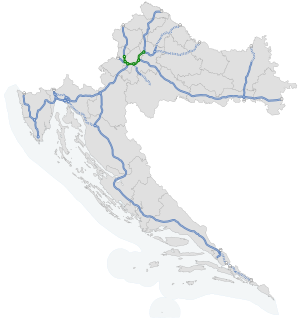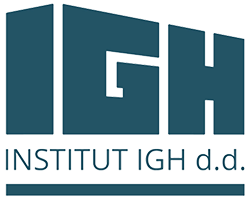Related Research Articles

The Istrian Y is a highway complex in the Croatian highway network, consisting of section A8 Matulji-Kanfanar and section A9 Slovenian border-Kanfanar-Pula. It is called the Istrian Y because it is shaped like the letter Y, with the three stretches all meeting at Kanfanar interchange in south central Istria. The complex was built and will be maintained by the company BINA Istra until 2027. Both highways have a speed limit of 110 km/h (68 mph).

The A1 motorway is the longest motorway in Croatia, spanning 476.3 kilometers (296.0 mi). As it connects the nation's capital Zagreb to the second largest city Split, the motorway represents a major north–south transportation corridor in Croatia and a significant part of the Adriatic–Ionian motorway. Apart from Zagreb and Split, the A1 motorway runs near a number of major Croatian cities, provides access to several national parks or nature parks, world heritage sites, and numerous resorts, especially along the Adriatic Coast. National significance of the motorway is reflected through its positive economic impact on the cities and towns it connects as well as its importance to tourism in Croatia.

The A2 motorway is a motorway in the Hrvatsko Zagorje region of northern Croatia, connecting Zagreb to the Macelj border crossing and Slovenia. The A2 motorway is part of the European route E59 and the Pan-European Corridor Xa. The motorway spans 59.2 kilometres (36.8 mi) between the Slovenian border and the Jankomir interchange within the Zagreb bypass, providing road connections to a number of cities and towns besides Zagreb, including Krapina, Zabok and Zaprešić. All sections of the motorway, except the northernmost one between the Macelj border crossing and Trakošćan, and the southernmost one near Zagreb, are tolled, using a closed toll collection system.

The A4 motorway is a motorway in Croatia spanning 97.0 kilometres (60.3 mi). It connects the nation's capital, Zagreb, to the city of Varaždin and to Budapest, Hungary via the Goričan border crossing. The motorway represents a major north–south transportation corridor in Croatia and is a part of European routes E65 and E71. The A4 motorway route also follows Pan-European corridor Vb.

The A6 motorway is a motorway in Croatia spanning 80.2 kilometres (49.8 mi). It connects the nation's capital, Zagreb, via the A1, to the seaport of Rijeka. The motorway forms a major north–south transportation corridor in Croatia and is a part of European route E65 Nagykanizsa–Zagreb–Rijeka–Zadar–Split–Dubrovnik–Podgorica. The A6 motorway route also follows Pan-European corridor Vb.

The A7 motorway is a 42.4-kilometre-long (26.3 mi) motorway in Croatia. It connects the nation's largest port in Rijeka, to the Croatian motorway network, as well as to the Rupa and Pasjak border crossings to Slovenia. The motorway forms part of a longitudinal transportation corridor in Croatia, and it is a part of European route E61 Villach–Ljubljana–Trieste–Rijeka. The A7 motorway route south of Orehovica interchange, where it also intersects Pan-European corridor Vb, is a part of European route E65.

The A8 motorway is a 64.0-kilometre (39.8 mi) toll motorway in Croatia. It connects the A7 motorway near Rijeka with the road network in the Istrian peninsula via the Učka Tunnel. The road terminates at the Kanfanar interchange with the A9 motorway, which with the A8 motorway forms the Istrian Y road system. The motorway's national significance is reflected in its positive economic impact on the cities and towns it connects, as well as its importance to tourism in Croatia. The importance of the motorway for tourism is particularly high during the summer tourist season, when its traffic volume increases by about 65%.

The A9 motorway is a north–south motorway in Croatia, with a length of 78.3 kilometres. Beginning in Pula, the largest city on the Istrian peninsula, it runs north to the Croatian motorway and expressway network at the Kanfanar interchange. Here it meets the A8 motorway, forming the Istrian Y road system. The A9 continues north from here to the Kaštel and Plovanija border crossings into Slovenia. The motorway represents a significant north–south transportation corridor in Croatia and is a part of the European route E751. The motorway's national significance is reflected in the positive economic impact on the cities and towns it connects, as well as its importance to tourism in Croatia. Importance of the motorway for tourism is particularly high during summer tourist seasons, when traffic volume increases by more than 80%.

The A11 motorway is an incomplete motorway in Croatia, 30 kilometres long. It connects the Jakuševec interchange of the Zagreb bypass, to the south of Zagreb, to Velika Gorica and onwards to Sisak, but currently reaches only the Lekenik exit, as of the planned 42-kilometre (26 mi) route, 30 km (19 mi) are completed. The motorway is planned as a north–south transportation corridor for commuter traffic between the cities.

Mota-Engil is a Portuguese group in the sectors of civil construction, public works, port operations, waste, water, and logistics. The chairman of the board of directors is António Mota and Gonçalo Moura Martins is the company's CEO. Jorge Coelho has led the group's Executive Committee from 2008 to 2013 and currently is a consultant in Mota-Engil's Strategic Advisory Council.

The European route E751, or E751, as defined by the Declaration on the Construction of Main International Traffic Arteries of 1975, and subsequent documents which amended the treaty, is an east–west Class-B branching European road route. Originating in Rijeka, Croatia, where it diverges from European route E61 before passing through the Kanfanar interchange, the route connects Pula, Rovinj, Poreč and Umag in Croatia with Koper in Slovenia. The route provides a high-performance road link in Istria and Slovenian Littoral. Unlike most routes, the E751 centers on the Kanfanar interchange and has three arms, each extending to Rijeka, Pula and Koper. The total length of the route, including all the route arms, is 160 km (99 mi).

Zagreb bypass is a U-shaped motorway partially encircling Zagreb, Croatia. The largest part by far, between Jankomir and Ivanja Reka interchanges, was built between 1977 and 1979, while the Ivanja Reka – Sveta Helena section was built between 1996 and 1999. The bypass is 48.9 kilometres (30.4 mi) long, tracing around the city from the northwestern suburb of Zaprešić to Sveta Helena in the northeast. The bypass crosses the Sava River twice and comprises a bridge across the Sava-Odra floodwater overflow canal. As the busiest sections between Jankomir and Buzin interchanges carry traffic volume of approximately 45,000 AADT, it is the most heavily used motorway sector in Croatia.

Porr AG is a construction group listed on the Vienna Stock Exchange with its headquarters in Vienna. It is one of the largest Austrian construction companies and is active nationally and internationally in all sectors of the construction industry: from civil engineering including traffic route construction, tunnelling and special civil engineering, to building construction, environmental engineering and facility management.

D404 is a state road connecting A7 motorway Draga interchange to the eastern part of the city of Rijeka, and to the Port of Rijeka, Brajdica container cargo terminal. The road is 3.5 km (2.2 mi) long, and 60% of the route is carried by various structures, such as tunnels and viaducts. The road opening had a number of delays, even though associated construction works were virtually complete for a long time. In the meantime, the road was used as a parking space. Finally, on May 30, 2011, the D404 road was open to traffic considerably enhancing access to Brajdica and eastern parts of Rijeka. Approximately two thirds of the road are classified as an expressway with 3 lanes, although the section between Vežica and Draga interchanges has 4 lanes.

INSTITUT IGH, d.d. is a Croatian company active in civil engineering professional services and scientific research, including development of designs, studies, supervision, consulting, investigation works, assessments, laboratory testing and instrument calibration. The company has received certificates for the services it provides, namely: EN ISO 9001, EN ISO 14001 and OHSAS 18001.

The Drežnik Viaduct is located in Karlovac, Croatia, immediately to the south of the Karlovac interchange on the A1 motorway. It is the longest viaduct in Croatia, spanning 2,485 metres (8,153 ft). It is executed in seven segments, separated by expansion joints. The viaduct was constructed by Konstruktor, Split, as the main contractor, and Viadukt and Hidroelektra of Zagreb as subcontractors in 2000 and 2001.

Veliki Gložac Tunnel is one of 13 tunnels found on the Croatian A6 motorway route. It is 1,126 metres (3,694 ft) long and consists of two tunnel tubes. It is located between Vrbovsko and Bosiljevo 2 interchanges. The tunnel is tolled within the A6 motorway closed toll collection system. There are no other toll plazas related to use of the tunnel. Construction of the tunnel was completed by Viadukt and Hidroelektra.

The Zečeve Drage Viaduct is located between the Bosiljevo 2 and Vrbovsko interchanges of the A6 motorway in Gorski Kotar, Croatia, just to the west of the Veliki Gložac Tunnel. It is 939.2 metres (3,081 ft) long. The viaduct consists of two parallel structures: the first one was completed in 2004, and the second one in 2008. The viaduct is tolled within the A6 motorway ticket system and there are no separate toll plazas associated with its use. The viaduct was completed by Viadukt.
Hreljin Vidauct is located between the Vrata and Oštrovica interchanges of the A6 motorway in Primorje-Gorski Kotar County, Croatia, just to the west of Tuhobić Tunnel. It is 544.85 metres (1,787.6 ft) long. The viaduct consists of two parallel structures: The first one was completed in 1995 by Hidroelektra, and the second one in 2008 by Konstruktor. The viaduct is tolled within the A6 motorway ticket system and there are no separate toll plazas associated with use of the viaduct. The viaduct was designed by Hidroelektra.

Vrata Tunnel is one of the shortest tunnels on the Croatian A6 motorway route. It is only 257 metres (843 ft) long and consists of two tunnel tubes. It is located between Oštrovica and Vrata interchanges. The tunnel is tolled within the A6 motorway closed toll collection system. There are no other toll plazas related to use of the tunnel. The tunnel was excavated by Viadukt using New Austrian Tunneling method. The tunnel was originally designed to be 325 metres (1,066 ft) long, but it was shortened due to the landslide on the western portal in the zone of contact between Paleozoic and carbonate layers. The tunnel is noteworthy since it comprises a 58-metre (190 ft) bridge spanning a cavern found during excavation.